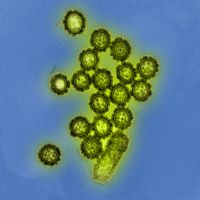Influenza A virus subtype H1N1

Influenza A virus subtype H1N1, commonly known as the swine flu virus, is the subtype of influenza A virus that caused the H1N1 flu pandemic in 2009. An earlier H1N1 variant is also believed to have caused the 1918-1919 pandemic known as the Spanish flu.[1]
H1N1 2009 pandemic[edit | edit source]
Influenza A subtype H1N1 strains caused a small percentage of all human flu infections in 2004–2005. In June 2009, the World Health Organization (WHO) declared a new strain of swine origin as a pandemic, naming it A/H1N1pdm09. It spread worldwide and had caused about 17,000 deaths by the start of 2010. The H1N1 influenza pandemic was declared over on August 10, 2010.[2] This variant of H1N1 is now a strain found in the usual seasonal flu group. Many people now have some level of immunity to this flu virus, so it is no longer considered as much of a concern as it was during 2009-2010. H1N1 protection has been included in the annual flu vaccines for a number of years now.[2][3]
Spanish flu[edit | edit source]
The H1N1 variant that caused the 1918-1919 "Spanish flu" pandemic was also believed to have come from swine (pigs), before mutating to infect humans.[1]
Other swine flu viruses[edit | edit source]
Other strains of inflenza A that evolved from swine include:
Influenza vaccines[edit | edit source]
Annual influenza vaccines protect against different influenza A subtypes including H1N1 and H3N2, and both groups of inflenza B.[3][4]
ME/CFS[edit | edit source]
- 2015, Chronic fatigue syndrome/myalgic encephalomyelitis (CFS/ME) is associated with pandemic influenza infection, but not with an adjuvanted pandemic influenza vaccine.[5]
Pandemic influenza A (H1N1) infection was associated with a more than two-fold increased risk of CFS/ME. We found no indication of increased risk of CFS/ME after vaccination. Our findings are consistent with a model whereby symptomatic infection, rather than antigenic stimulation may trigger CFS/ME.[5]
Learn more[edit | edit source]
- Swine flu - NHS
- Types of Inflenza - CDC
See also[edit | edit source]
References[edit | edit source]
- ↑ 1.0 1.1 Anhlan, Darisuren; Grundmann, Norbert; Makalowski, Wojciech; Ludwig, Stephan; Scholtissek, Christoph (January 2011). "Origin of the 1918 pandemic H1N1 influenza A virus as studied by codon usage patterns and phylogenetic analysis". RNA. 17 (1): 64–73. doi:10.1261/rna.2395211. ISSN 1355-8382. PMC 3004067. PMID 21068184.
- ↑ 2.0 2.1 "Swine flu (H1N1)". National Health Service. October 3, 2018. Retrieved November 11, 2021.
- ↑ 3.0 3.1 "Key Facts About Seasonal Flu Vaccine". Centers for Disease Control and Prevention. November 2, 2021. Retrieved November 11, 2021.
- ↑ "The national influenza immunisation programme 2021 to 2022" (PDF). Public Health England. August 2021.
- ↑ 5.0 5.1 Magnus, Per; Gunnes, Nina; Tveito, Kari; Bakken, Inger Johanne; Ghaderi, Sara; Stoltenberg, Camilla; Hornig, Mady; Lipkin, W. Ian; Trogstad, Lill (November 17, 2015). "Chronic fatigue syndrome/myalgic encephalomyelitis (CFS/ME) is associated with pandemic influenza infection, but not with an adjuvanted pandemic influenza vaccine". Vaccine. 33 (46): 6173–6177. doi:10.1016/j.vaccine.2015.10.018. ISSN 1873-2518. PMID 26475444.

